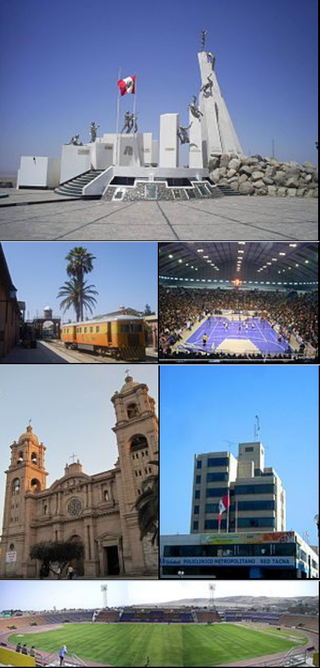
Tacna, officially known as San Pedro de Tacna, is a city in southern Peru and the regional capital of the Tacna Region. A very commercially active city, it is located only 35 km (22 mi) north of the border with Arica y Parinacota Region from Chile, inland from the Pacific Ocean and in the valley of the Caplina River. It is Peru's tenth most populous city.
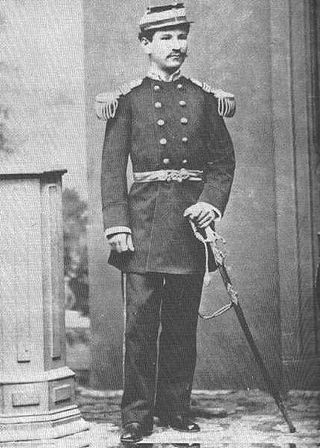
Alfonso Ugarte was a Peruvian civilian turned military commander during the War of the Pacific, between Peru and Bolivia against Chile. He held the rank of colonel.

Francisco Bolognesi Cervantes was a Peruvian military colonel. He is considered a national hero in Peru and was declared patron of the Army of Peru by the government of Peru on 2 January 1951.
Mariano Emilio Bustamante y Mantilla was a Peruvian hero of the War of the Pacific between Chile and Peru, fighting in the battles of San Francisco, Tarapacá and Arica, in which he was killed while combating.
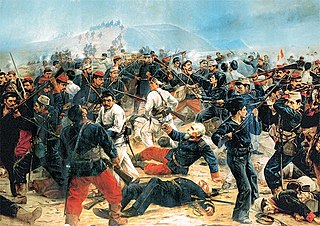
The Battle of Arica, also known as Assault and Capture of Cape Arica, was a battle in the War of the Pacific. It was fought on 7 June 1880, between the forces of Chile and Peru.

After the naval campaign of the War of the Pacific was resolved, the Chilean terrestrial invasion began.
Tacna Locomotive park, is a park, located at the Alameda Bolognesi, in the centre of the city of Tacna, Peru. It features a 19th-century train that carried Francisco Bolognesi and his troops to the defence of the Morro de Arica during the War of the Pacific.

José Juan de Dios Mateo Osbaldo Botaro Lepiani Toledo was a Peruvian painter. He is primarily known for historical and patriotic scenes; notably those related to the War of the Pacific.

The Plaza Bolognesi is a roundabout located in the Lima District and the Breña District, in the capital of Peru. It is located at the intersection of Brazil Avenue, Arica Avenue, Alfonso Ugarte Avenue, Guzmán Blanco Avenue, and 9 December Avenue.

The Arica House of Culture, also known as Former Arica Custom House, is a building located in Arica, Chile. Designed by Gustave Eiffel's company, it was built between 1871 and 1874, prior to the annexation of Arica by Chile. The building was declared a National Monument of Chile on November 23, 1977, within the category of Historic Monuments.

San Lorenzo de Tarapacá, also known simply as Tarapacá, is a town in the region of the same name in Chile.
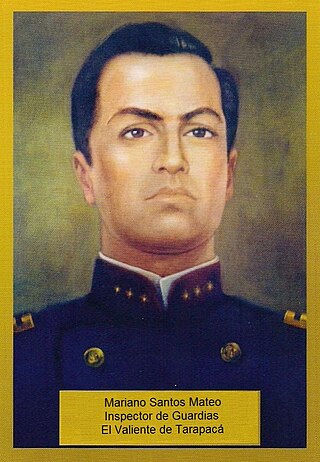
Mariano Santos Mateo was a Peruvian Civil Guard officer who fought in the War of the Pacific. He became famous by capturing, during the Battle of Tarapacá, the war ensign of the 2nd Infantry Regiment "Maipo" of the Chilean Army, for which he was nicknamed the Brave Man of Tarapacá.

The Chilean–Peruvian territorial dispute is a territorial dispute between Chile and Peru that started in the aftermath of the War of the Pacific and ended significantly in 1929 with the signing of the Treaty of Lima and in 2014 with a ruling by the International Court of Justice. The dispute applies since 2014 to a 37,610 km2 territory in the Chile–Peru border, as a result of the maritime dispute between both states.

La respuesta, also known as La respuesta de Bolognesi, is an 1891 oil painting by Peruvian painter Juan Lepiani. It forms part of the collection of the Combatants of the Morro de Arica Museum.

El último cartucho is an 1899 oil painting by Peruvian painter Juan Lepiani. It forms part of the collection of the Combatants of the Morro de Arica Museum.

The Combatants of the Morro de Arica Museum, also known as the Casa de Bolognesi, is a house museum dedicated to the War of the Pacific and its battle of Arica, located at the birthplace of Francisco Bolognesi, in the historic centre of Lima, Peru.

The Port of Arica is the main port of the northernmost coastal Chilean city of Arica. The northern part of the port, known by its acronym, MASP Arica, is operated by the Peruvian State.
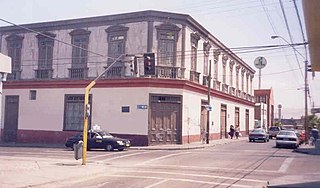
The Casa Yanulaque is a historical building located in the Chilean city of Arica, in the corner of 18 de Septiembre and General Lagos streets. It is owned by the Peruvian State as part of the 1929 Treaty of Lima, and currently houses its consulate-general.

Juan José de la Cruz Salvo y Poblete was a Chilean soldier who fought in the War of the Pacific as a Sergeant major. He is best known for being the envoy sent by the Chilean Army to the headquarters of Francisco Bolognesi's garrison in Arica to request his surrender after the allied defeat at the Battle of Tacna, to which Bolognesi replied by saying he would "fight until the last cartridge is spent".

María Graña Ottone Friendship Park is a public park located at the intersection of Alfredo Benavides and Caminos del Inca avenues, in Santiago de Surco, Lima, Peru. It features a monumental arch based on the one that once stood at Arequipa Avenue, in Lima District.


















